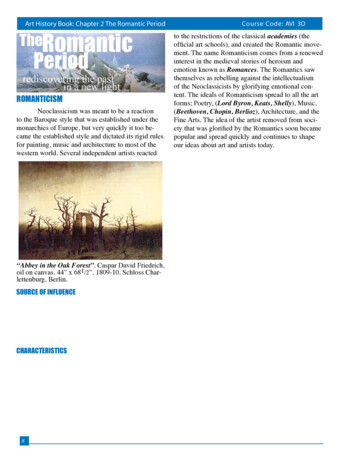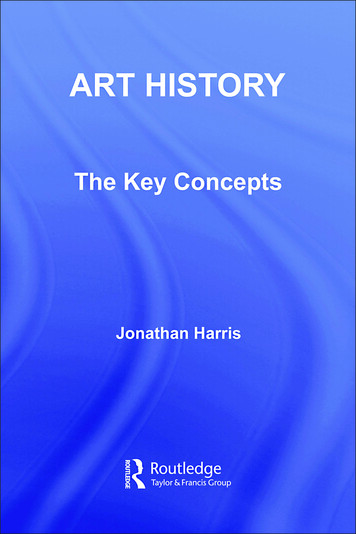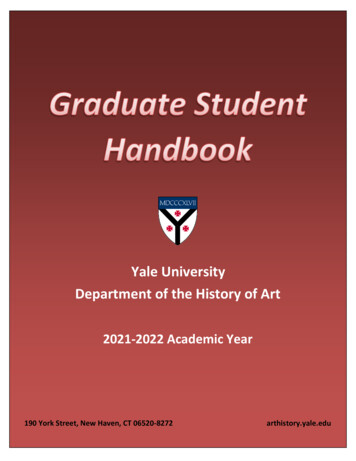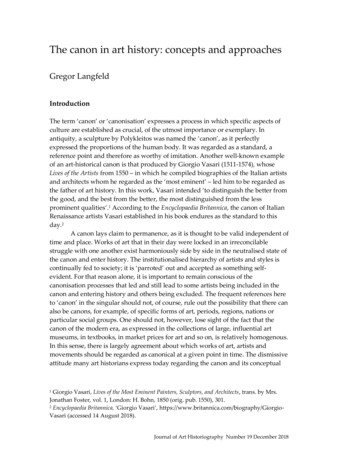
Transcription
Art History Book: Chapter 2 The Romantic PeriodROMANTICISMNeoclassicism was meant to be a reactionto the Baroque style that was established under themonarchies of Europe, but very quickly it too became the established style and dictated its rigid rulesfor painting, music and architecture to most of thewestern world. Several independent artists reacted“Abbey in the Oak Forest”. Caspar David Friedrich.oil on canvas. 44” x 681/2”. 1809-10. Schloss Charlettenburg, Berlin.SOURCE OF INFLUENCECHARACTERISTICS8Course Code: AVI 3Oto the restrictions of the classical academies (theofficial art schools), and created the Romantic movement. The name Romanticism comes from a renewedinterest in the medieval stories of heroism andemotion known as Romances. The Romantics sawthemselves as rebelling against the intellectualismof the Neoclassicists by glorifying emotional content. The ideals of Romanticism spread to all the artforms; Poetry, (Lord Byron, Keats, Shelly), Music,(Beethoven, Chopin, Berlioz), Architecture, and theFine Arts. The idea of the artist removed from society that was glorified by the Romantics soon becamepopular and spread quickly and continues to shapeour ideas about art and artists today.
Art History Book: Chapter 2 The Romantic PeriodCourse Code: AVI 3OROMANTICISM IN ARCHITECTURESOURCE OF INFLUENCEMost Romantic art revived styles from the past and architecture hadthe widest range of revival styles. After the Greek revival we find the NeoGothic, Neo-Renaissance and the Neo-Baroque together with a good mix ofEastern influences.CHARACTERISTICSThe most common characteristic of Romantic architecture is its liftingof architectural elements from almost any source.CHARLES GARNIER (1825-1898)left. Exterior of the Paris Opera, right. Grand Staircase of the Paris Opera.1874. Charles Garnier, Paris.YOUR NOTES ON GARNIER9
Art History Book: Chapter 2 The Romantic PeriodCourse Code: AVI 3OROMANTICISM IN PAINTINGSOURCE OF INFLUENCEPainting became the greatest creative achievement of the Romantic movement. Literature became an important source of inspiration for painters, providingthem with a new range of subjects and emotions. A renewed interest in the Baroque inspired many of the younger artists already tired of Neoclassicism.CHARACTERISTICSRomantic painting tends to capture violent activity, strong emotions andenergetic brush work not seen in Neoclassical works.THEODORE GERICAULT (1791-1824)Gericault used a very stablecompositional triangle to helpcontain the chaos of the scene“The Raft of the Medusa”. Theodore Gericault. oil oncanvas. 1818-19. 259x 324 cm. The Louvre, ParisYOUR NOTES ON GERICAULT10to achieve greater impact theartist went to extreme lengthsprepaing for this paintinginclude sketching dead bodies
Art History Book: Chapter 2 The Romantic PeriodCourse Code: AVI 3OEUGENE DELACROIX (1789-1863)Liberty is an allegorical figureincluded to strengthen thetheme of the painting and tieit in with historical works ofart“Liberty Leading the People”. Eugene Delacroix oilon canvas. 1830. 259x 324 cm. The Louvre, ParisDelacroix identifies himselfwith the cause by puttinghimself into the paintingYOUR NOTES ON DELACROIX11
Art History Book: Chapter 2 The Romantic PeriodCourse Code: AVI 3OCASPAR DAVID FRIEDRICH (1774-1840)the wreck of the boat is barelyvisible within the massive icepackthe stability of the triangle isin opposition to the tensioncreated by the numerousdiagonal lines“The Polar Sea”. Caspar David Friedrich. oil on canvas.1824. 97.7” x 128.2 cm . Kunsthalle, Hamburg.YOUR NOTES ON FRIEDFRICH12
Art History Book: Chapter 2 The Romantic PeriodCourse Code: AVI 3OROMANTICISM IN SCULPTURESOURCE OF INFLUENCESculpture was one area that did not really yield any works of "genius".Like other Romantic artforms the sculptors were influenced by the ancientGreeks and medieval times, and the late unfinished works of Michelangelo.CHARACTERISTICSThe chief characteristic of Romantic sculpture is its "attitude" and scale.AUGUSTE BARTHOLDI (1834-1904)in this piece it is mostly thetheme and attitude whichlinks it to Romanticismhelp from Gustave Eiffelmade the construction of thisenormous sculpture possible“Statue of Liberty, (Liberty Enlightening the World)”.Auguste Bartholdi. copper sheeting over metal armature.1875-84. 151’ 6” high. Liberty Island, New York HarbourYOUR NOTES ON BARTHOLDI13
Art History Book: Chapter 2 The Romantic PeriodCourse Code: AVI 3OTERMS TO KNOWIndexEMeclectic 9Enlightenment 8Medusa 10Michelangelo 13FNfacade 9Neo-Baroque 9Neo-Gothic 9Neo-Renaissance 9GGreek revival 9Gustave Eiffel 13LWWilliam Parry 12Louvre 9KEY CONCEPTSWhich periods in history influenced the Romantics?What aspects of style and approach to art do Romantics share?14
Art History Book: Chapter 2 The Romantic Period Course Code: AVI 3O ROMANTICISM IN PAINTING YOUR NOTES ON GERICAULT SOURCE OF INFLUENCE Painting became the greatest creative achievement of the Romantic move-ment. Literature became an important source of inspiration for painters,











